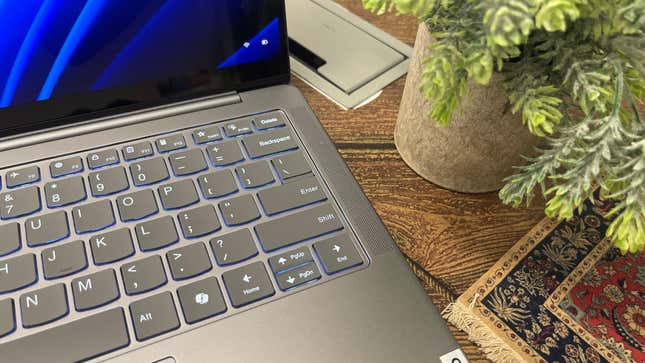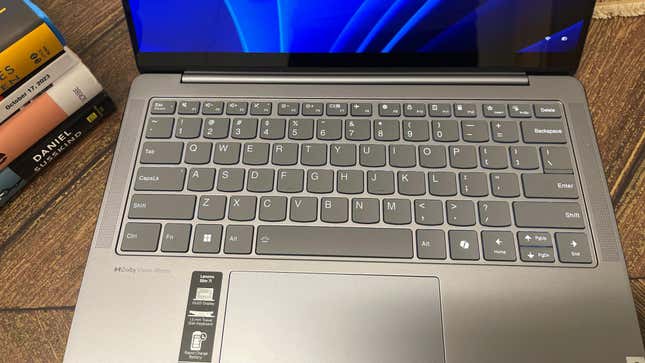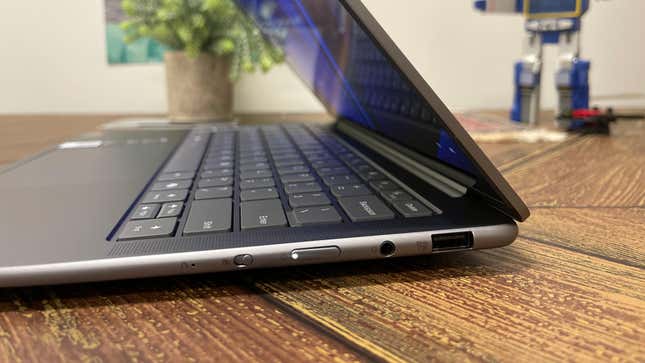Lenovo Slim 7i
An overall impressive machine with a durable build, clicky keyboard, generous port spec, and a sufficiently good display. What it needs is a bump in CPU power, though. At $1000, its benchmark results aren’t very exciting.
Pros
Robust, durable build
Slim profile
Keyboard is nice and snappy
Fairly good display
GPU performance is surprisingly good
Cons
Not exactly lightweight
Trackpad feels flimsy
CPU performance is just okay
The Lenovo Slim 7i is a machine that offers premium features at an affordable price point in a notebook-type sleek and slim body. Affordability and versatility are supposed to be this laptop’s two main selling points.
While its midrange status puts it in the affordable category, its processor doesn’t provide the power that would make me recommend it at the price point it’s currently offered at—$1000. It impresses in pretty much all other areas but would need to be offered for cheaper to be worth the investment.
Lenovo Slim 7i Design
Very slim and pretty solid but not lightweight
Measuring just 0.59 inches thick, the Slim 7i does justice to its name. It’s even 0.01 inches slimmer than the Lenovo ThinkPad X1, which we praised for being extremely slim.
However, it isn’t as light as you’d want an ultra-slim laptop to be. I got excited when I saw ‘slim’ in the name and assumed it would compete against some of the slimmest machines on the market. But, weighing 3.06 lbs, that wasn’t the case. A real lightweight laptop should be at least under three pounds. The ThinkPad X1 boasts a 2.8-pound body, and the difference in weight as I held both of these laptops simultaneously was perceptible.
I will say that its body feels pretty robust. The all-aluminum body exudes durability and feels better than the plastic body on the ThinkPad X1. It’s a give-and-take situation; the give would is the bump in weight, and the take is a sturdy, reliable build. Lenovo claims the Slim 7i offers a military-grade design that passes the MIL-STD 810H certification and Lenovo’s own in-house reliability tests. I’m unable to test this claim, but I know I’d feel pretty comfortable stowing away this laptop in my suitcase for travel.
A metal body also looks better than a plastic one. I like the Luna Grey color and the matte exterior. It gives off a clean, premium look. If we’re talking design, $1000 is reasonable for a well-made machine like this.
Lenovo Slim 7i Keyboard and Trackpad
Tight keyboard, not-so-tight trackpad
Taking multiple Monkeytype typing tests on both the Slim 7i and my personal laptop, MacBook Air, and performing extremely poorly on the Slim 7i, I realized that adjusting to its hard, tight keys would take some time. Don’t get me wrong; they’re not bad at all. They’re just the tight ones that take a while to get used to. In fact, I love their snappy, loud, tactile feel and actually prefer it. The 1.5mm travel also feels great because I’m so used to the less than 1mm travel on my MacBook Air. There are no backlight brightness options on the keyboard, just on or off.

I love how well the keyboard is sized. There’s plenty of room for every key; not even the punctuation or arrow keys are trimmed. Even with such a generously sized, spacious keyboard, there’s room on both sides for upward-firing Dolby Atmos speaker grilles.

You’ve probably heard of the new Copilot key that new Windows keyboards are getting. The Slim 7i also sports one; you can use it to access AI quickly—Copilot—for your everyday activities. Pressing it instantly launches a chatbot on the side with a field for asking whatever you want and some prompts to help you get started.
The trackpad is almost the opposite of the keyboard on this laptop. It’s way too loose and feels as if it’s been overused to the point of being permanently depressed. If you can get past its overly loose feel, you might like how well it responds to you. The travel distance is impressive, and its overall feel is pretty bouncy. It feels as if a huge spring inside passionately returns your click back to you.
Lenovo Slim 7i Performance
Core Ultra 7 isn’t very ultra
Intel recently renamed its traditional “i” series to Core and Core Ultra. Core Ultra targets the premium segment, while Core is for mainstream users. The Slim 7i sports the 14th Gen Intel Core Ultra 7 155H processor along with integrated Intel Arc graphics. You get Thunderbolt 4, Wi-Fi 7, Bluetooth 5.4, and PCIe 5.0. The configuration sent to us features 32GB RAM and 1TB SSD.
Like every single thing that’s been released lately, this laptop also offers certain AI features. Its Core Ultra processor is divided into three separate engines: CPU, GPU, and NPU. The NPU is responsible for handling complex mathematical computations required for AI-related tasks. Specifically made for functions such as object detection and natural language processing, it is being marketed as the next big thing. Lenovo promises that the NPU on the Slim 7i allows for high performance while consuming as little power as possible.
GPU testing on this laptop impressed me even though I wasn’t expecting much considering it doesn’t have a dedicated graphics card. I ran my usual Heaven Unigine GPU benchmark and got excellent results. It scored an average FPS of 61 and hit a max FPS of 145. The core i5 on the HP Envy Move, with 21 and 47 FPS (average and max, respectively), was put to shame with these scores.
I can’t say the same about the CPU results. The Core Ultra 7 has consistently been underwhelming. I got a 2100 on the single-core Geekbench CPU test. This isn’t much higher than the 2064 that I got on the i5 Envy Move. While this laptop is marketed as an everyday machine for light usage, I still expected more from it, especially considering how much the Core Ultra 7 processor is being touted. Also, considering its $1000 price puts it in the midrange category, it’s fair to expect more power from it.
There’s an IR sensor right next to the FHD 1080p camera, making it easier and faster to log in. It also means you’ll save battery because it will detect your presence and turn the display off as soon as you move away from it. You also get a physical privacy shutter with a switch on the side of the laptop with all the ports.

The port spec is pretty good. On the right, there’s a USB 3.2 Type-A port, a 3.5mm jack, a power button, and a privacy shutter switch. The left side features an HDMI 2.1 port and two USB Type-C ports with Thunderbolt 4 tech. Apart from not-so-common ports like ethernet and Kensington lock, the Slim 7i covers pretty much every need.
The battery life is quite average. It will last you around eight hours on a full charge. But the recharging is quick. It went from being dead to 33% charged in just 20 minutes.
Lenovo Slim 7i Display
Who doesn’t love a touchscreen?
There are two display options on the Slim 7i: touch and non-touch. We were sent the configuration with the glass touch-screen display. You get a 14-inch OLED display with a WUXGA (1920×1200) resolution and a 16:10 aspect ratio. Like most other modern laptops, this one’s also TUV Rheinland Low Blue Light certified, which means it will be easy on your eyes.
Both display options come with Dolby Vision tech, which Lenovo claims makes the viewing experience more immersive and lifelike. I do think that the display is pretty sharp and features rich colors, but calling it lifelike would be a bit of an overstatement, in my opinion. It didn’t stun me the way the ThinkPad X1’s display did. The brightness on the Slim 7i maxes at 400 nits, and the refresh rate at 60Hz.
Lenovo Slim 7i Verdict
Apart from some horsepower, the Slim 7i doesn’t particularly lack anything. Sure, its trackpad could have been a bit tighter, and a couple of grams could have lost its weight, but none of these are dealbreakers. What’s truly a disappointment is the below-average CPU performance despite several claims of the Core Ultra 7 being a super competitive chip. For $1000, I wouldn’t recommend the Slim 7i unless its price is significantly slashed—which is very typical of Lenovo— in which case, it might not be such a bad option if all you want out of it is basic everyday tasks.
Trending Products

Cooler Master MasterBox Q300L Micro-ATX Tower with Magnetic Design Dust Filter, Transparent Acrylic Side Panel…

ASUS TUF Gaming GT301 ZAKU II Edition ATX mid-Tower Compact case with Tempered Glass Side Panel, Honeycomb Front Panel…

ASUS TUF Gaming GT501 Mid-Tower Computer Case for up to EATX Motherboards with USB 3.0 Front Panel Cases GT501/GRY/WITH…

be quiet! Pure Base 500DX Black, Mid Tower ATX case, ARGB, 3 pre-installed Pure Wings 2, BGW37, tempered glass window

ASUS ROG Strix Helios GX601 White Edition RGB Mid-Tower Computer Case for ATX/EATX Motherboards with tempered glass…










